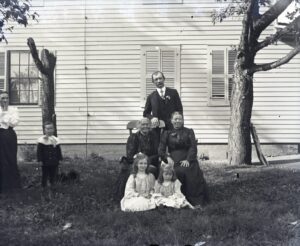The definition of genealogy is relatively straightforward. According to Merriam-Webster, genealogy is the study of family ancestral lines. Anyone can do genealogy, though professional genealogists or formal genealogy programs like Ancestry can assist amateurs looking to begin researching their family history.
Though the definition of genealogy is reasonably simple, its history in America is complicated. The origin of American genealogy is often dated to 1771, when Luke Stebbins published his New England family’s genealogy. Genealogy was dismissed as elitist pretension during the Revolution, but its popularity grew after the conclusion of the war. Throughout the early 1800s, genealogy served to create familial connections and solidify and strengthen American family units.

“Four Generations” by Harry Kinley
Following the Civil War, hereditary organizations popped up across the nation. Genealogy and tracing ancestral lines formed the basis for hereditary societies that created exclusionary definitions of whiteness, such as the Daughters of the American Revolution. In the late 1800s and early 1900s, some Americans weaponized genealogy in debates over immigration to the United States. White elites who were concerned about their social status used genealogy as a means of proving their white heritage and excluding new immigrants. The eugenics movement fed on genealogical ideologies centered around heredity, race, blood, and stock. Genealogical journals of the time hailed eugenics, or the pseudoscience of improving the race by controlling reproduction, as a solution to modern societal issues. After World War II and the atrocities committed by the Nazis in the name of racial purity, the American eugenics movement declined rapidly, though it never disappeared entirely. Separately, the study of genealogy also waned. For a few decades, genealogy languished in the academy, considered to be only of value as entertainment. However, genealogy would see a second day in the sun.
The 1960s and 1970s were a time of great social tumult that drove Americans to seek out sources of stability and connection. From Vietnam protests to second-wave feminism, social movements altered how Americans viewed themselves. In the midst of challenges to old institutions, Americans wanted to feel connected to their ancestors. Additionally, the Mormon Church opened genealogical libraries across America in the 1960s, and more non-Mormon patrons began their research throughout the 1970s. These libraries provided widespread access to ancestral history resources.
American writer Alex Haley spurred on the genealogy craze with his wildly successful book Roots. Published in 1976, Roots narrated the life of enslaved African Kunta Kinte and followed the lives of his descendants down to the author himself. In 1977, the book was adapted into an equally successful television show. Roots generated a widespread fascination with ancestry and family discovery in the 1970s and 1980s. With the advent of the Internet and other technologies in the 1990s, Americans could access enormous genealogical databases online.
Currently, genealogy is an immensely popular hobby in the United States. Many of the Ohio History Connection’s patrons are also passionate genealogists. Genealogy gives us the opportunity to both connect with the stories of our ancestors and trace our own histories. It helps us find our place within American history. However, exclusionary genealogy still rears its ugly head. For example, DNA testing has provided a new means of family connection and healing from ancestral wounds. However, in some cases, it serves to reveal lies and half-truths in family stories or expose dark secrets. For example, DNA testing has revealed affairs, adoptions, half-siblings, and more. Currently, DNA testing is a battlefield over genetic and familial privacy. Who has the right to uncover family secrets, and are there some histories that should remain hidden?
Despite genealogy’s dark past, current diversity and inclusion efforts reveal strong evidence for a brighter future. Many libraries, archives, and historical societies have organized webinars and workshops that focus on inclusive genealogy. For example, the Ohio History Connection’s 2021 workshop series “Where My Single Folk?” focuses on researching single ancestors to create a more inclusive family tree. Many of the “Where My Single Folk?” workshops explored methods for researching non-dominant groups, including women, people of color, and LGBTQ+ people.
Likewise, the educational community has begun to focus on how to teach inclusive genealogy and family history to students. Teachers are rethinking family tree assignments that don’t include non-nuclear family structures, don’t consider access to information, and/or are not trauma-informed. One alternative is the Circles of Caring Community project, which acknowledges and celebrates all caring adults in children’s lives. A PDF of the assignment from Welcoming Schools is located here. Since the 1970s, genealogy has become more multicultural and inclusive, but the work is not yet done.
At its core, genealogy engages questions of identity. Who are we and where do we come from? What stories shape us as people? As modern definitions of family and identity change, genealogy must change alongside them. Our family trees should reflect us, in our fullest and most beautiful forms.
***
Further reading and sources:
The Lost Family: How DNA Testing is Upending Who We Are by Libby Copeland
Family Trees: A History of Genealogy in America by Francois Weil
“The Dark Side of Our Genealogy Craze” by Honor Sachs
“The Mythical Quest for Our Ancestors is Big Business” by Julia Creet
“Why Are Americans Mad About Genealogy?” by Deirdre Foley Mendelssohn
“How Genealogy Became Almost as Popular as Porn” by Gregory Rodriguez
“Genealogy in the “Information Age”: History’s New Frontier” by Elizabeth Shown Mills
“Why It’s Time to Rethink Family Tree Assignments” by Kimmie Fink